#canada during world war 2
Photo
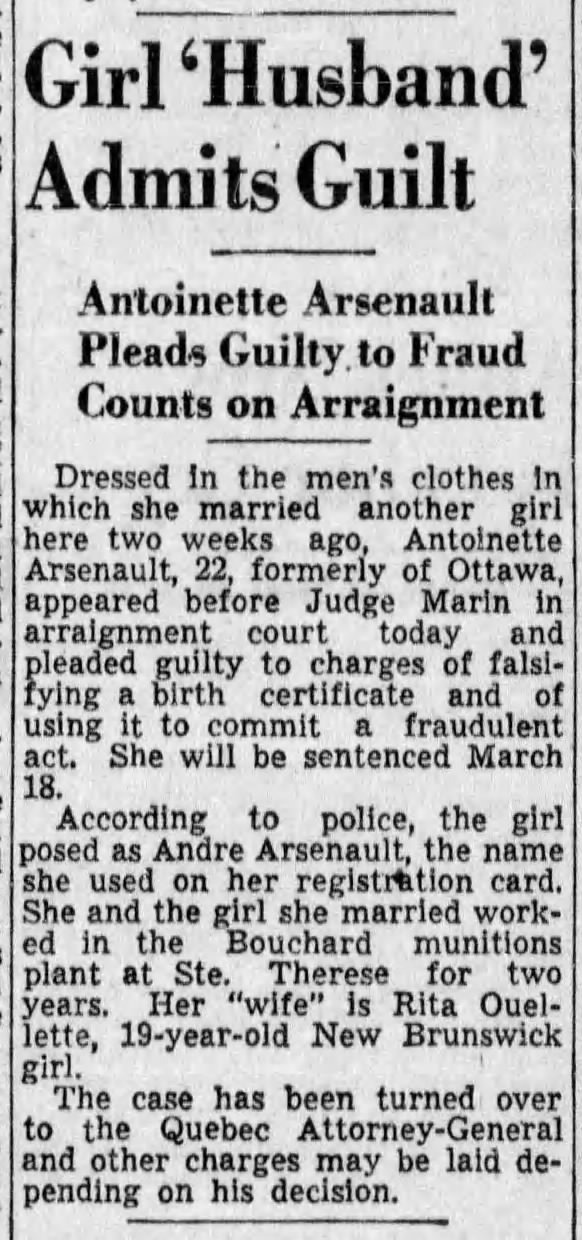
“Girl 'Husband' Admits Guilt,” Montreal Star. March 14, 1942. Page 3.
---
Antoinette Arsenault Pleads Guilty to Fraud Counts on Arraignment
---
Dressed in the men's clothes in which she married another girl here two weeks ago, Antoinette Arsenault, 22, formerly of Ottawa, appeared before Judge Marin in arraignment court today and pleaded guilty to charges of falsifying a birth certificate and of using it to commit a fraudulent act. She will be sentenced March 18.
According to police, the girl posed as Andre Arsenault, the name she used on her registration card. She and the girl she married worked in the Bouchard munitions plant at Ste. Therese for two years. Her "wife" is Rita Ouellette, 19-year-old New Brunswick girl.
The case has been turned over to the Quebec Attorney-General and other charges may be laid depending on his decision.
#montreal#ottawa#arraignment court#cross dressing#same sex marriage#same sex relationships#history of homosexuality in canada#queer history#false pretences#forged documents#canada during world war 2#women in the toils#crime and punishment in canada#history of crime and punishment in canada#male impersonator
24 notes
·
View notes
Text

"2 jeunes gens sont morts de façon tragique," La Presse. August 10, 1943. Page 3.
---
Ils auraient bu de l'alcool de bois dimanche dernier. - Enquête demain.
----
Deux adolescents ont succombé, ce matin, à un empoisonnement causé par l'absorption d'alcool de bols. Tous deux sont de S.-Henri. Il s'agit de Marcel Roy, 14 ans, 5172, rue Ste- Marle, et de Marcel S.-Jean, 15 ans, 5061 ouest, rue Notre-Dame,
Le premier a succombé vers 2 h., ce matin, en l'hôpital Général de Verdun où il avait été transporté hier soir. Le second est mort vers 8 h. ce matin à l'hôpital Général, division ouest. Les cadavres furent transportés à la morgue de Montréal où une enquête sera ouverte demain matin avec un jury sous la présidence du Dr Pierre Hebert, coroner conjoint du district de Montréal.
Témoignages des parents
D'après les témoignages des parents des victimes voici les détails de cette tragédie: Les deux jeunes hommes étalent partis de leur domicile respectif de bonne heure dimanche après-midi pour se rendre, avec un groupe d'amis, au parc Lafontaine. Ils y avaient passé l'après-midi.
Au cours de la soirée du même jour, ils s'étalent rendus, avec les mêmes amis, à une soirée d'amateurs qui avait lieu au stade Notre- Dame, chemin de la Côte S.-Paul.
Le frère d'une des victimes, M. Lucien S.-Jean, nous a déclaré que ce serait au cours de la soirée que les deux malheureux auraient absorbé la boisson mortelle.
Il nous a encore déclaré qu'hier matin, Mme Hugues S.-Jean réveilla son fils, Marcel, à l'heure habituelle, pour aller travailler. Cependant, le jeune homme refusa de se lever, révélant à sa mère qu'il souffrait d'un violent mal de tête et de maux d'estomac. Elle lui demanda alors ce qu'il avait mangé ou bu la veille. Il répondit qu’il n'avait rien bu et qu'il se sentait simplement malade. Sur la fin de l'après-midi d'hier, M. Lucien S.-Jean constata que l'état de son frère empirait. "Les yeux lui sortaient de la tête", dit-il, et il avait l'écume à la bouche.
"Il était presque méconnaissable". C'est alors qu'll fit venir le Dr Laurin, de la rue Notre-Dame ouest, qui lui conseilla de faire transporter le malade à l'hôpital.
Mustisme complet
"Nous avons tenté par tous les moyens, durant la journée de lundi, de lui faire avouer ce qu'il avait absorbé, mais ce fut en vain. Ce n'est qu'à l'hôpital qu'il nous déclara avoir pris de l'alcool avec des amis. Il n'a j'amais voulu nous dire qui lui avait donné la boisson".
"Après avoir fait transporter mon frère à l'hôpital, ajouta M. Lucien S.-Jean, je me rendis chez les parents du jeune Roy. Je savais que Marcel Roy soufrait du même mal. Je leur enjoignis de faire transporter leur fils à l'hôpital.
M. et Mme Joseph Roy, parents de l'autre victime, nous ont déclaré qu'ils tentèrent eux aussi de faire avouer à leur enfant ce qu'il avait pala. Es n'obtinrent pas plus de succès. Le Dr Archambault prodigua les premiers soins au jeune Roy.
Les deux adolescents conservèrent le plus absolu mutisme jusqu'à leur dernière heure. Mais on croit qu'un adulte leur aurait fourni l’alcool. Le Dr Jean-Marie Roussel, médecin-légiste, nous déclarait ce matin qu'à leur äge un ou deux onces d'alcool de bols suffisaient pour causer la mort. Même si les deux victimes avalent déclaré plus tôt qu'ils avaient absorbé une telle boisson on aurait eu peu de chances de les sauver.
Les sergants détectives Fitzparick et Senecal, de l'escouade des homicides font aujourd'hui une en- quête dans ce cas. On s'attend à des révélations prochaines.
Legende:
MARCEL ROY (à gauche) et MARCEL SAINT-JEAN, morts dans des circonstances étranges à l'hôpital après avoir bu, dimanche dernier, ce que l'on croit être de l'alcool de bois.
#montreal#alcohol poisoning#wood alcohol#dangerous drinking#substance abuse#blind drunk#youth in the toils#young delinquents#youth delinquency#canada during world war 2#crime and punishment in canada#history of crime and punishment in canada#homicide squad#police investigation
6 notes
·
View notes
Photo

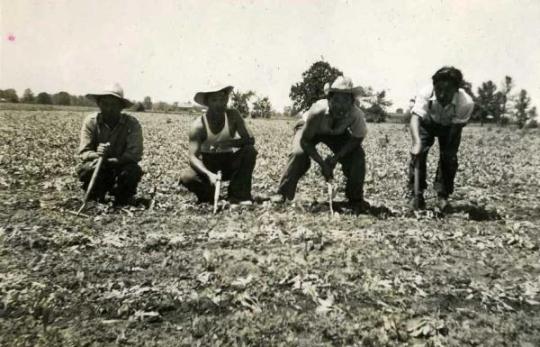
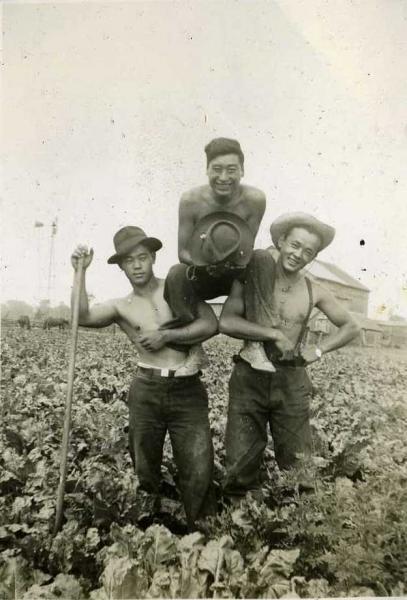

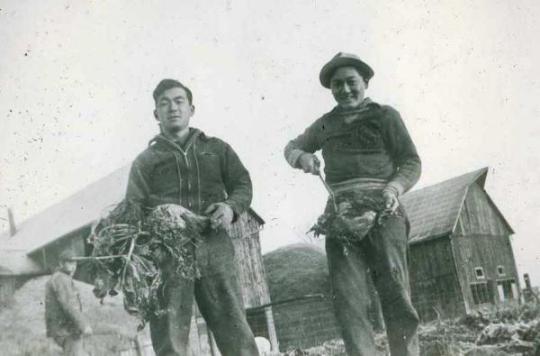
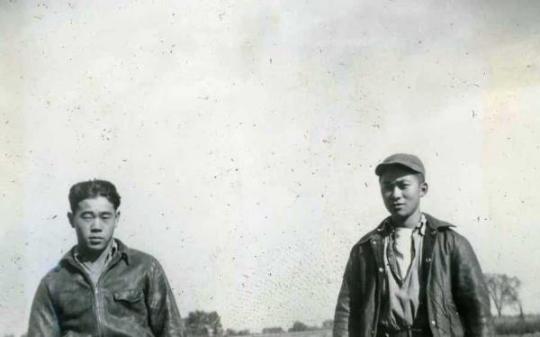
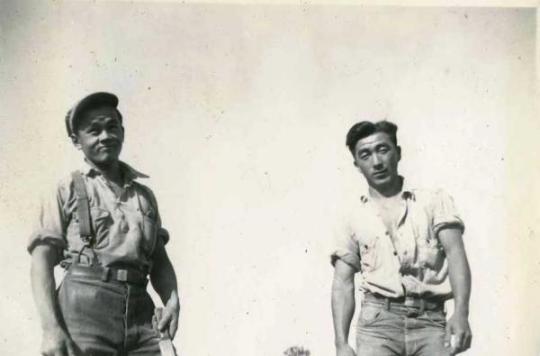
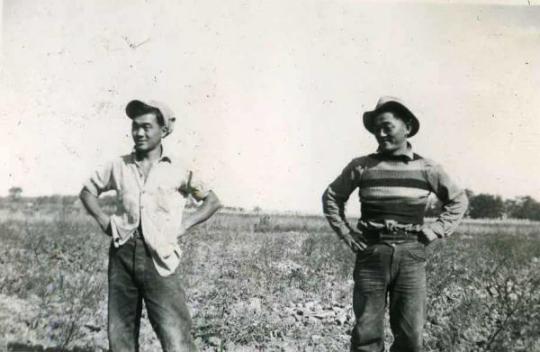
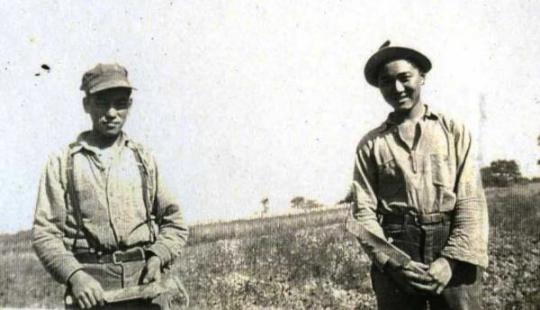
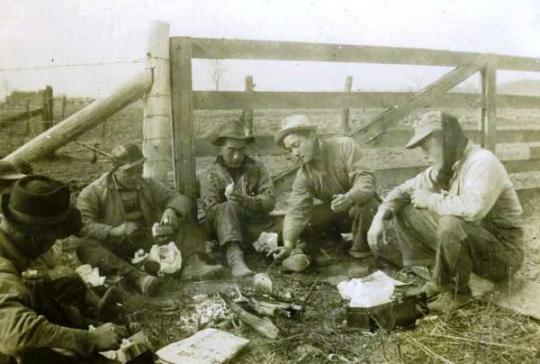
Photographs taken by Yon Shimizu, a Japanese-Canadian who was exiled from the west coast of Canada to Ontario during the second World War, along with hundreds of other Japanese-Canadian men. In 1942, he worked along with several dozen other men as a farm labourer with the Ontario Farm Service Force near Glencoe, equidistant from Sarnia, London and Chatham. These are photographs he took of the sugarbeet harvest, and were digitized from a DVD of Yon Shimizu’s scrapbook by the Southwestern Ontario Digital Archive. All dated 1942 though they definitely show a range of time during that summer and fall - final harvesting of sugarbeets is in late October or November, and the last photo shows the men huddling from the cold in November.
1) At Glencoe train station; the ‘49′ Gang, according to the caption. Left to right: Tsutomu "Stum" Shimizu, E. Ono, T. Okamoto, T. Kuwabara.
2) Blocking 48 Gang, that is, thinning or "blocking" the sugar beets; left to right: S. Miyashita, Y. Madokoro, S. Kawahara, J. Henmi.
3) “He-Men.” Left to right: B. Hoita, K. Goto, T. Hoita.
4) “Siesta Time!” T. Okamoto taking a siesta during the beet harvest.
5) “Block Busters!” Showing off some huge sugarbeets during the thinning (blocking) process.
6) Gang 5 "Toppers A-1" Butch Hoita and Stum Shimizu.
7) Gang 5 "Toppers A-1" Tommy Hoita and Tomo Okamoto.
8) Gang 5 "Toppers A-1" Stum Okamoto and Esao Ono.
9) Gang 5 "Toppers A-1" Tom Kuwabara and Yon Shimizu. Toppers defoliate the beets as close to harvesting as possible.
10) Lunch, Cold November Day
#japanese canadian internment#internment camps#japanese canadians#canadian history#farm camp#nikkei#nikkei kanadajin#canada during world war 2#dictatorship within democracy#relocation camp#defence of canada regulations#glencoe#kent county#chatham#london ontario#racism in canada#black and white photography#archival photography
84 notes
·
View notes
Text

"12,500 STEEL WORKERS OUT AT THREE PLANTS; WAR OUTPUT SUFFERS," Toronto Star. January 14, 1943. Page 1.
----
Loss Set at 170,200 Tons Monthly, Two-Thirds of Nation's Production
----
ASK WAGE BOOST
----
Three of Canada's basic steel producing plants today are tied up by strikes. A total of 12,500 men have quit work at Sault Ste. Marie, Ont.; Sydney and Trenton, N.S., to enforce demands for wage increases.
Five thousand workers at Sydney, N.S. - on strike for the third day - were joined early today by 4,000 at Sault Ste. Marie and 3,500 at Trenton.
Strikes at Sydney and Sault Ste. Marie tied up two of the dominion's three basic steel producing plants. It was estimated by government figures the loss in production at the two plants would amount to; 170,212 tons a month, or two-thirds of the country's basic steel output.
Workers at the Steel Company of Canada at Hamilton have decided to defer strike action until the company management has been approached regarding negotiations with the United Steelworkers of America (C.I.O.).
Picket Lines Set Up
The strike at the Sault began officially at 7 a.m. when members of the day shift didn't report. Picket lines were set up.
The strikers were not joined by 500 transportation department employees and machinists, members of American Federation of Labor unions. These entered the plant to work today and were not interfered with by pickets. An additional 500 men engaged on construction work were not direly affected by the strike, it was reported.
It was announced that 300 men had been left in the plant to do maintenance work. No effort was made to stop those who wished to continue their regular work in the plant, but as buses neared the picket lines, a union representative boarded each and read the following statement: "This bus after its next stop will go through a picket line - any working man going through that line to work is undermining the fight of his fellow-workers for decent living standards. Let your conscience be your guide."
#sault ste. marie#sydney nova scotia#trenton#strike#picket line#picketing#steel workers#steel plant#steel industry#algoma steel#dominion steel#united steel workers of america#central industrial organization#hamilton#wage demands#wage increase#wage freeze#price controls#canada during world war 2#working class struggle
9 notes
·
View notes
Text

"CANADA IS 'HOME' ΤΟ 135 IMMIGRANTS," Toronto Star. June 24, 1943. Page 3.
----
Canada became the official home of 135 foreign-born residents this week when they took the oath of allegiance to His Majesty the King. William Stangret, Parkham Ave., native of Poland, has lived here 16 years. He took the oath proudly.
Miss Helme Rahikka, native of Finland, has lived in Toronto for the past 13 years. "This is the happiest moment of my life," she exclaimed as she received her papers proclaiming her a Canadian citizen.
Private W. Strand, who has lived here 18 years, served with the Canadian Army before transferring to the Norwegian forces. A native of Norway, he went to school here. He wears a long service medal.
Tom Dorosh, native of Russia. came to Toronto 16 years ago. His father, brothers and sisters are fighting with the Russian forces. "I am happy to be a real Canadian if not exactly a new one," he said.
#toronto#immigration to canada#naturalized canadian#canadian citizen#canadian citizenship#canada in the british empire#russian immigration to canada#russian canadians#finnish canadians#finnish immigration to canada#norwegian immigration to canada#polish immigration to canada#polish canadians#canada during world war 2
3 notes
·
View notes
Text

"Canadian Army Women to Train As Anti-Aircraft Gun Operators," Toronto Star. April 30, 1943. Page 27.
----
BRITISH WOMEN TERRITORIALS OPERATE "A.A." GUNS
----
Ottawa, April 30 - (CP) - Members of the Canadian Women's Army Corps will be trained as "plotter telephonists" and will eventually take their place with men manning anti-aircraft artillery, defence headquarters has announced.
Women in Britiain's auxiliary territorial service - the British women's army - have been used on similar duty for some months. Some have helped operate London's guns during air raids.
Women selected must have grade 10 in education, have ability at map-reading and mathematics and possess a "keen interest" in artillery, the statement said.
#canadian women's army corps#artillery plotter#anti-aircraft guns#aa guns#air defence#auxiliary territorial service#canada in the british empire#canadian army#women at war#women in uniform#world war ii#canada during world war 2
6 notes
·
View notes
Text

"CLOTHING APPEAL FOR RUSSIA "SNOWED UNDER" BY DONATIONS," Toronto Star. June 3, 1943. Page 37.
----
This load of clothing and shoes under which 14-year-old Jack Swartz is laboring is just a small part of the "proceeds" collected for Russia's homeless by canvassers of the Young Men's and Women's Hebrew association. In 10 city blocks, Toronto citizens donated so much clothing that 75 depots were used to hold it. Every article will reach Russia through the clothing section of the Canadian Aid to Russia Fund.
#toronto#young men's and women's hebrew association#aid to russia#mutual benefit society#jewish canadians#allied powers#eastern front#russian front#red army#canada during world war 2#charitable philanthropy
2 notes
·
View notes
Text

""Patriotic" Thieves Take Victory Bonds," Montreal Star. May 7, 1943. Page 3.
---
BURGLARS broke into the Atlas Dry Goods Company store at 2038 St. Lawrence boulevard last night, smashed open the safe, and stole $700 in cash and $1,200 worth of Victory Bonds.
The thieves entered an adjoining vacant house and first tried to pierce a hole through through the wall between the two buildings. Unsuccessful, they next broke through a skylight to the roof crossed to the Atlas Building and chopped an opening to the second floor. It was then an easy matter to reach the safe and smash it. The theft was only discovered at 9 a.m. today.
#montreal#dry goods store#burglary#burglars#safecrackers#safecracking#stolen cash#victory bonds#canada during world war 2#crime and punishment in canada#history of crime and punishment in canada
4 notes
·
View notes
Photo


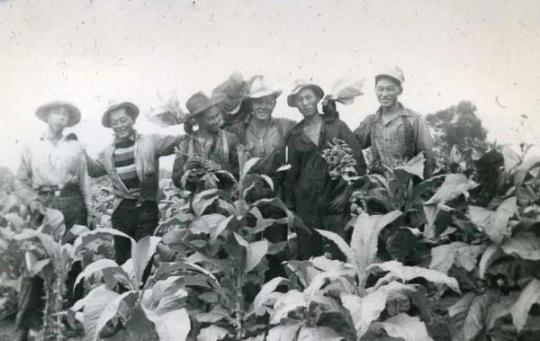
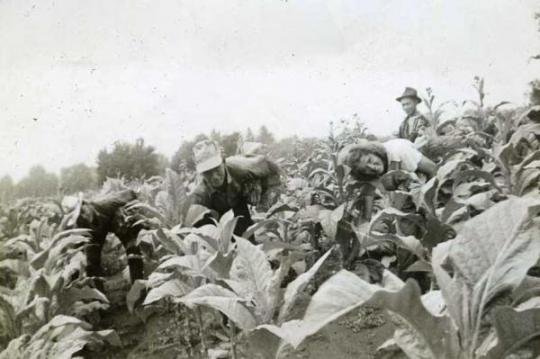

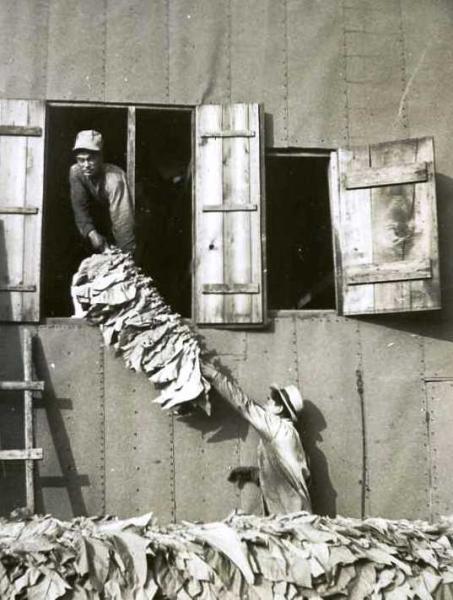
Photographs taken by Yon Shimizu, a Japanese-Canadian who was exiled from the west coast of Canada to Ontario during the second World War, along with hundreds of other Japanese-Canadian men. In 1942, he worked along with several dozen other men as a farm labourer with the Ontario Farm Service Force near Glencoe, equidistant from Sarnia, London and Chatham. These are photographs he took of the tobacco harvest, and were digitized from a DVD of Yon Shimizu’s scrapbook by the Southwestern Ontario Digital Archive and the University of Windsor’s Leddy Library. All dated 1942 though they definitely show a range of time during that summer, likely in August. Notably, in a number of these pictures the internees are mingling and working alongside white farm labourers and farmers.
1) “Sheiks.” Left to right: Tomo, "Killer", Stum, relaxing near the farm house of the tobacco fields they would be harvesting.
2) “Where's The End?” Yon Shimizu, the photographer, becomes the subject, standing in the tobacco fields.
3) In The Tobacco Fields. Left to right: Hama, Ono, Shimizu, Hoita, Tosa, Kuwabara.
4) “In Action!”
5) Transporting The Tobacco Leaves.
6) “To The Kiln.” The kiln was used to store, steam, cure, and then pack the tobacco into bales for auction.
#japanese canadian internment#internment camps#japanese canadians#canadian history#farm camp#nikkei#nikkei kanadajin#canada during world war 2#tobacco farm#tobacco growing#harvest season#tobacco harvest#farm workers#tobacco#relocation camp#glencoe#kent county#chatham#london ontario#racism in canada#black and white photography#archival photography
62 notes
·
View notes
Photo
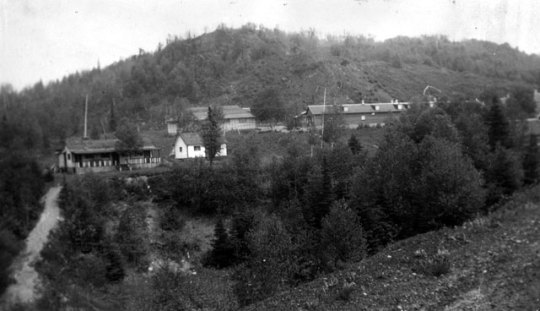





Photographs from the ‘relocation camp’ for Japanese-Canadian internees in Schreiber, Ontario, with photos digitized and put up by Schreiber Public Library. I’ve posted about the Schreiber camp before, using extracts from a great article on the subject, but here’s a recap:
“Official removal of Japanese Canadians began in March of 1942....Two days later, about 100 “British subjects” were to board a train to go from Vancouver to Schreiber, Ontario. Of the roughly 100 men ordered to board the train, eighty-five refused. BCSC officials were unable to coax the men onto the train, and ended up incarcerating them in an “Immigration Shed.” These same officials told the imprisoned men that if they did not “divulge the names of the instigators” of the action they would be hauled before the courts, but no one was willing to inform on their compatriots. RCMP Commissioner S.T. Wood then asked for a blanket Order of Internment that would allow him to formally arrest and incarcerate the men. When a push failed, a shove would apparently do. These men would go on to become some of the first of what would eventually amount to over 800 Japanese Canadians who were interned for defying the forced labour and evacuation regime.
...
By April, Dave Watanabe had already “established himself as spokesman” [at the Schreiber camp. He is visible in the second photo, second from left, middle row, identified as ‘Butch’ Watanabe] At a meeting with Graham Pipher, a British Columbia Security Commission [BCSC] apparatchik, Watanabe demanded the workers’ “rights as Canadian citizens,” mainly regarding access to the nearby town of Schreiber. The evacuees stated that their “volunteering” to work in Ontario should have earned them these promised minor freedoms. Although not described as a job action, Pipher noted that sixty people attended this “meeting” to discuss grievances when they should have been working. Building on an earlier slowdown campaign, when the workers got word that the state was to restrict their movement, they brought their working pace to a crawl and threatened to strike.
Pipher commented that any restriction “on free movement etc.” would cause unrest to become “accentuated” and that he would lose control of the camp. The central administration pondered the imposition of stricter discipline, but the notion was junked well before implementation. From the start, the camps were not jail-cum-work-camps, and the incarcerated workers had much more latitude than the authorities had intended. As the camp was “small” and lacking in guards the Japanese enjoyed relatively free mobility. The “Japs at this camp [quickly] found favour with the majority of the citizens of Schreiber,” and before long they were patronizing “local’s stores and places of amusement,” without “any adverse criticism” from the townsfolk. It was of concern to T.S. Mills, the chief engineer on the project, that the men had access to the town and the telegraph office, and had the audacity to send uncensored messages directly to their families in British Columbia.
[CW Warning: Racial slurs]
Mills related the story of a local railroad man’s daughter, who inquired of her father whether it was acceptable to dance with the Japanese. The railroader told his daughter that “as long as the Jap was sober and conducted himself properly, he would sooner she dance with a Jap than a Dago.” The railroader’s comment sheds some light on the process of racialization that was unfolding, solidifying, and mutating during the Second World War, and how the hierarchies of “race” were subject to significant gradation and shift.
Although following the war there would be an “elevation” of some “peoples” to “white” status, the war period was still riven by the hierarchies of preference and stratification within the racial-taxonomic realm. Mills “saw problems arising” and predicted there “will be cases of too much intimacy between those young, well-mannered and conducted Japs and local girls.”
Despite the reservations of Pipher and the BCSC (let alone the state) about free movement, Mills noted that “too stringent regulations at this time will cause an unfavorable condition,” and that “policies and regulations” need to be determined by need and on a local basis. Although there certainly was martial rule in the camps, and many of the people in the camps were officially interned and under much stricter control, the reality was that spaces were consistently mediated and negotiated via direct action.
The BCSC thought it impossible to restrict free movement at Schreiber camp. They believed they had a responsible partner in Watanabe as a leader, and as Watanabe had the camp’s “full support” they assumed that they could maintain rule by proxy. Nearby Jackfish Camp had a beer parlour, and the BCSC wondered if adding a pub could be enough to keep the Japanese from wandering to the local dance halls. In the end, the BCSC decided against imposing their plan of a blanket movement ban. Interestingly, the state also gave up on censoring the mail of these specific workers, unless they were sending it abroad, as the mail “could not contain information of much value to the enemy”—a freedom not extended to interned anti-fascist Canadians. Although Pipher wanted to move Wanatabe to another camp to “break” the impromptu organization, the BCSC thought better of it, noting that “should he be moved, he would cause trouble elsewhere.” Preferring to contain the trouble rather than turning local agitators into travelling organizers, Dave Wanatabe was left alone.”
- quotes from Mikhail Bjorge, “Destroying the Myth of Quietism: Strikes, Riots, Protest, and Resistance in Japanese Internment.” in Mochoruk, Jim; Hinther, Rhonda L., ed. Civilian internment in Canada: histories and legacies : an edited collection. Winnipeg: University of Manitoba Press, 2020.
Photos from top to bottom, with original captions from the SPL:
1) Gold Range Mine. Senator Hayes home and bunk houses 2 miles east of Schreiber. This became the main buildings for the Schreiber internment camp. SPL 1996.1.11.
2) Men of the Schreiber camp, 1942.
Rear L - R: 1) ? 2) Fred Vogami 3) ? 4) ? 5) ? 6) ? 7) Jack Sadoio Shikitani 8) ? 9) ? 10) ? 11) Willie Kimitoshi Utsunomiya 12) Swede Sawada 13) George Suzuki;
Middle L - R: 1) ? 2) Butch Watanabe 3) Sam Hagino 4) Fred Akira Shititani 5) Koichi Nishikaze;
Front L - R: 1) Mickey Hogara 2) George Mochizuki 3) ? 4) John Kikuo Shikatani 5) ? 6) Art Tateishi 7) Sandy Ono
SPL 1996.1.20
3) Men working at the Japanese internment camp two miles east of Schreiber 1942-1944. George Keeno on left. SPL 1996.1.12.
4) Internees at Japanese Internment Camp two miles east of Schreiber. Men were sent to the camps to assist in road building in the area between Schreiber and Jackfish. SPL: 1996.1.19.
5) Left - Right: Minoru Nagasawa , Matahuru 'Mutt' Otsu. Taking a break from chopping wood, 1942.
6) Some of the residents of a Japanese internment camp, during World War II. The camps were outside of Schreiber, about 2 miles east on Highway 17.
Standing L - R: 1) Doug Arai 2) Punchy Ito 3) Don Otsu 4) Mitsuo Otsu 5) Len Takeshima 6) Maise Nishimura 7) Syd Nishimura. Seated L - R: 1) Larry Makino 2) Ernie Dikawa 3) George Nishimura. Some of the residents of a Japanese internment camp, during World War II. The camps were outside of Schreiber, about 2 miles east on Highway 17.
SPL: 1996.1.18
All photos Schreiber Public Library.
#japanese canadian internment#internment camps#japanese canadians#canadian history#prison camp#japanese immigration to canada#nikkei#nikkei kanadajin#canada during world war 2#dictatorship within democracy#defence of canada regulations#northern ontario#schreiber#work camp#racism in canada
93 notes
·
View notes
Text
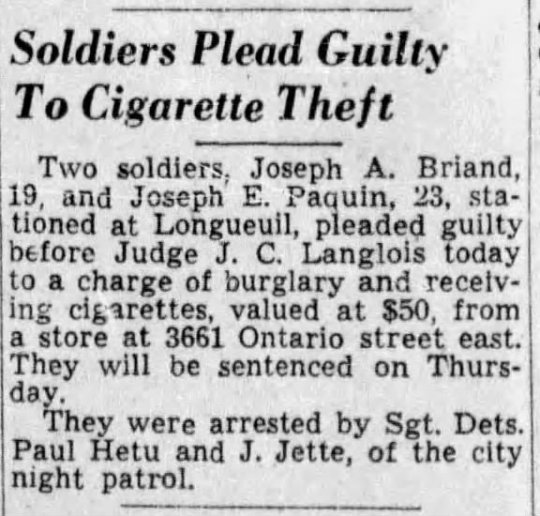
"Soldiers Plead Guilty To Cigarette Theft," Montreal Star. August 3, 1943. Page 3.
---
Two soldiers, Joseph A. Briand, 19, and Joseph E. Paquin, 23, stationed at Longueuil, pleaded guilty before Judge J. C. Langlois today to a charge of burglary and receiving cigarettes, valued at $50, from a store at 3661 Ontario street east. They will be sentenced on Thursday.
They were arrested by Sgt. Dets. Paul Hetu and J. Jette, of the city night patrol.
#montreal#longueuil#burglary#receiving stolen cigarettes#burglars#canadian soldiers#stolen cigarettes#canada during world war 2#crime and punishment in canada#history of crime and punishment in canada
3 notes
·
View notes
Text

"37 Juveniles Sent to C.A.Α.," Montreal Star. May 7, 1943. Page 4.
---
Army Gives Data On 'Teen-Age Soldiers
---
OTTAWA, May 7-(C.P.) - A total of 37 soldiers under 19 years of age were sent overseas from Alberta during 1942, John Blackmore, New Democracy leader, was informed in a reply to a question tabled in the House of Commons.
Of these 23 had less than six months training, and 11 of the 23 had less than five months while seven of the 23 had less than four months. The seven were in technical arms and their training was to be completed overseas.
Mr. Blackmore's question asked if any "teen-age" boys had been sent overseas. The reply said there was no regulation against sending men over 19 overseas and it was assumed the question referred to those under that age. The reply said a routine order prohibited sending men under 19 overseas and a further order had to be issued in July, 1942, to emphasize the necessity for rigid adherence to the earlier order.
Of the 37 soldiers referred to, 29 had gone overseas before the further order was issued and all but one of the remainder had left before the end of August, 1942. Five soldiers under 18 made false age declarations on enlistment.
To the same question the Air Force and Navy replied that it was impossible to obtain the information from their records without a large amount of work and expense which would interfere with other essential work.
#house of commons#member of parliament#new democracy party#child soldiers#history of canadian youth#teenagers#canadian active service force#military recruitment#military enlistment#manpower shortage#canada during world war 2#social credit#alberta history
3 notes
·
View notes
Text

"A l'Ecole française d'été de McGill," La Presse. August 11, 1943. Page 3.
---
Cet instantané a été pris pendant la collation des grades de l'Ecole française d'été de l'Université McGill, ce matin, au Royal Victoria College, rue Sherbrooke ouest. On voit M. LOUIS ALLARD, professeur émérite à l'Université Harvard, au moment où il remettait la Médaille d'argent du lieutenant-gouverneur à Mme Dora Helen Smyth, de Belleville, Ont., qui a conservé la plus haute note dans la section supérieure du cours de français. Dans le groupe des professeurs présents, on remarque, de gauche à droite: Mile YVONNE JUGE, Mile EDITH GARTLAND, M. LOUIS ALLARD, président d'honneur de la collation des grades; M. J. HOUPERT, M. J. DARBELNET, directeur de l'Ecole française d'été et du département français de l'Université McGill; Mme TOUREN-FURNESS et Me MADELEINE BODIER. (Cliché la "Presse".)
#montreal#mcgill university#royal victoria college#french school#french language instruction#two solitudes#elite canadians#anglo canadians#french canadians#canada during world war 2
2 notes
·
View notes
Text

"When you're all dressed up And no place to go.." Winnpeg Tribune. September 20, 1943. Page 11.
----
WITH just the heel of a box of shells and with only one of those AA cards for the gas, there's many a duck hunter who will do his duck hunting in front of the fireplace this year. The season opened in Manitoba this morning and quite a few, like Tom Lamont, of 183 Oakdean blvd., who posed for the picture above, must be satisfied with memories of trips to the marshes. The ducks haven't got it all their own way, however, for plenty of hunters had some shells left over from last year. As for new shells, even farmers, trappers and prospectors need a permit to buy them.
#winnipeg#hunting season#duck hunting#ammunition shortage#gasoline rationing#wartime rationing#duck hunter#great white hunter#canada during world war 2
4 notes
·
View notes
Photo

“STUFFED DOLLS WERE NAZIS AT BOWMANVILLE ROLL CALL,” Toronto Star. April 18, 1942. Page 2.
----
Papier Mache Figures Fool Guards at Parades for 10 to 24 Hours
---
ONE OF TWO SOUGHT
----
Two stuffed dummies with papier mache faces and lips painted red were paraded at roll call in the Nazi officers' internment camp at Bowmanville while Erie Boehle and Peter Krug made good their escape yesterday. This ruse, said to have been used by the Germans here on at least one other occasion, was successful due to painstaking work on the dummies.
The faces were moulded from wet paper. From a distance they were indistinguishable from a Nazi officer. For from 10 to 24 hours. it is these took the places of the escapees. Supported in the roll-call line-up, others spoke for the absentees. How the pair escaped is a mystery. None of the wire entanglements was cut, it is said.
Erich Boehle. 27-year-old Nazi flier, who was caught in Niagara Falls, N.Y, yesterday, was back behind barbed wire today while search continued for Peter Krug 21. another German airman, still at large. Absence of the two prisoners of war was reported Friday morning at at the Bowmanville officers' camp. although Boehle told Niagara Falls authorities he had escaped "several” days ago.
After Boehle had been caught yesterday in Whirlpool Park, along the Niagara river, a Niagara Falls, Ont. woman excitedly telephoned police to tell them she believed she had unwittingly played hostess to the escaped prisoner Wednesday night.
She a man answering the German's description had come to her home asking for something to eat, stating he had been refused food at a neighboring house. The woman said she took him in and gave him bread and jam.
May Have Swum River
Boehle's clothing-s gray suit resembling a uniform which roused the suspicions of police who picked him up was soaking wet when he was arrested. This led to belief that he may have crossed from Canada to the US by by swimming the lower Niagara river. An intensified search is being continued along the border on the possibility that Krug also may have crossed or be planning to cross the river to the U.S.
Both prisoners were in a group of 200 brought from Britain last week. When he was arrested Boehle is said to have denied having any knowledge of Krug's whereabouts. Boehle told authorities he was shot down over England in September, 1940. and escaped once before into New Brunswick.
Boehle was picked up by scout car police who were suspicious of his clothing. He produced papers which he claimed identified him as a member of the Royal Norwegian Air Force. in training at Toronto. but the papers were found to be bogus. The prisoner then admitted his identity.
Officers at RNA.F. headquarters here emphasized that the papers bore no resemblance to official R.N.A.F. papers.
"The R.N.A.F.” would like to make this point clear," the statement said. “The papers papers found on Boehle were completely fraudulent and not even similar to our identification papers. so they could not have been copies. We wish to correct any impression that this German could have had access to Norwegian papers in the forging of the ones he carried."
Posed for Pictures
Boehle, a blond, thick-set air force lieutenant, smilingly posed for pictures in the Niagara Falls. N.Y... police headquarters before being brought back across the border. He was driven across the Rainbow bridge in Canadian military ear. Krug is described follows: 137 as pounds, 5 feet 8 inches in height. medium build, fair complexion. clean shaven, blond wavy hair cut military style, brown eyes. medium mouth, normal teeth.
#bowmanville#niagara falls#prison break#escape from prison#prisoner of war#prisoner of war camp#airman#luftwaffe#world war II#canada during world war 2#border crossings#u.s.-canada border#history of crime and punishment in canada#crime and punishment in canada#escaped prisoners#dummy head
7 notes
·
View notes
Text

"Push Up in the Front … For Victory," Montreal Star. October 21, 1943. Page 12.
---
SPEED THE VICTORY! HATONS LA VICTOIRE!
----
Here is one of the most eye-striking sights in Montreal to mark Canada's Fifth Victory Loan campaign, one of the four specially painted street cars donated by the Montreal Tramways Company. Working as usual, each car will travel 200 miles every day of the drive and it is estimated will carry on an average, 128 passengers per hour.
#montreal#victory bonds#victory bond campaign#street car#public transit#mass transit#montreal street railways#war propaganda#canada during world war 2
2 notes
·
View notes